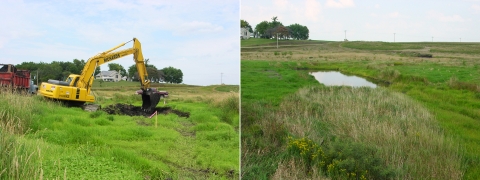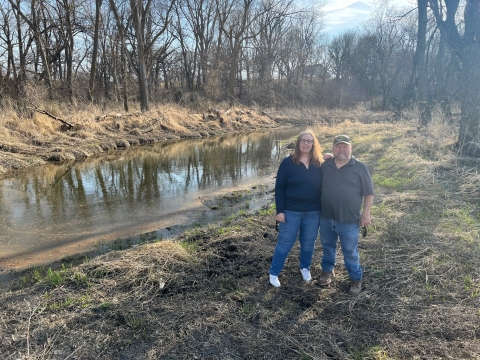In the heart of America's midwest, a quiet revolution in conservation is taking root. As the United States celebrates the 50th anniversary of the Endangered Species Act, the prairies and waterways of America's heartland have been quietly weaving an uplifting tale of partnership, resilience and ecological triumph. Kraig McPeek, U. S. Fish and Wildlife Illinois-Iowa Field Supervisor, shared his optimism about the effectiveness of the Endangered Species Act., "As we celebrate half a century of the Endangered Species Act, the story of the oxbow restoration and the Topeka shiner is a reminder of what we can accomplish together."
We at the U.S. Fish and Wildlife Service are part of a remarkable partnership creating ripples of change throughout the midwest. This coalition of state agencies, agricultural associations, and passionate farmers has come together with one purpose: to restore and safeguard Iowa's precious oxbow habitats and, in doing so, protect the stability of oxbow ecosystems. Our Partners for Fish and Wildlife Program acts as the very glue binding the coalition together.
Oxbows, U-shaped remnants of river meanders, are vital for ecosystem health, acting as biodiversity hotspots and playing key roles in water filtration and flood control serving as important habitat. Central to these habitats is the endangered Topeka shiner, a small, native freshwater fish. Its presence or absence reflects the overall health of the ecosystem.
An oxbow is formed when a winding curve of a river becomes isolated due to erosion of river banks and the creation of a new river channel during high water flow. Sediment builds up in oxbows. Oxbows dry out. They disappear altogether when plants cover them. The degradation of these special places, as seen in places like West Buttrick Creek in Iowa’s Raccoon River watershed, not only diminishes water quality but also threatens the survival of the Topeka shiner and other aquatic species. Restoring oxbows is crucial not just for this species, but for maintaining the health of freshwater systems.
With the 50th anniversary of the Endangered Species Act in 2023, the revival story of the Topeka shiner highlights the critical role of partnerships, innovation, and the sustained dedication of local communities.
Landowner partnership: The cornerstone of conservation
Without the commitment of landowners, the restoration of oxbow wetlands would remain a distant dream. Kathy Law and her husband, Dave Law, are Iowa farmers who participated in oxbow restoration on their land, stressed the significance of these partnerships, emphasizing, "Landowner involvement is paramount. Their commitment to preserving natural habitats has been the linchpin of this endeavor."
The narrative gets richer when we consider the multi-faceted benefits that farmers reap from oxbow restoration. For farmers, the benefits of participating in oxbow restoration extend beyond ecological preservation. Brandon Iddings of the Iowa Soybean Association noted, "Not only have these wetland restorations become a haven for endangered species, but they've also proved beneficial for crop yields."
In the heart of Iowa, where family farms dot the landscape and generations have tilled the same land, Kathy speaks with reverence about the soil underfoot. "Our land is not merely an income source," she begins, echoing the sentiments of countless Iowa farmers. "It's our heritage. For many, these lands have been passed down through generations. It's not just about profit, it's our lifestyle, our very way of life."
Kathy's commitment to the land is evident. But she also highlights a mutual relationship between conservation efforts and farming benefits. "When we participated in the oxbow restorations, the soil they removed was of such high quality that it was spread over one of our fields," she recalls. "This seemingly small act resulted in our corn yielding over 20 bushels more per acre. The only reason for this boost we can pinpoint is the improved quality of our soil from that deposited dirt."
For Kathy and many like her, conservation isn't just about protecting nature—it's about enhancing productivity and ensuring their land's legacy continues. "There are tangible economic benefits alongside the invaluable environmental advantages," Kathy emphasizes. "It's not just about doing the right thing for nature, but also ensuring our land remains prosperous for generations to come."
Joe emphasized the ease for farmers: "Through collaborations, farmers can participate in these restoration efforts without the burden of added costs."
What’s Next: Hope for the Topeka shiner
The restoration of oxbow habitats has been crucial for the Topeka shiner, with the U.S. Fish and Wildlife Service playing a significant role in bringing all the characters of this story together. When asked about their experiences working with partners on Topeka shiner conservation, staff shared different perspectives along the same narrative – the future for this little fish depends on collaborative conservation much like a community coming together to save the Topeka shiner.
This sentiment is echoed by Kathy, who sees the increasing participation of landowners in oxbow restoration as a sign of growing grassroots conservation efforts. The success story of the Topeka shiner and oxbow restoration, showcasing community and organizational collaboration, offers hope and a model for future endeavors.
"Every plot of land rejuvenated, every oxbow restored, brings us closer to a future where our natural habitats thrive," Brandon of the Iowa Soybean Association concluded.
We encourage more landowners to join this cause, providing resources and support for tailored restoration projects.







